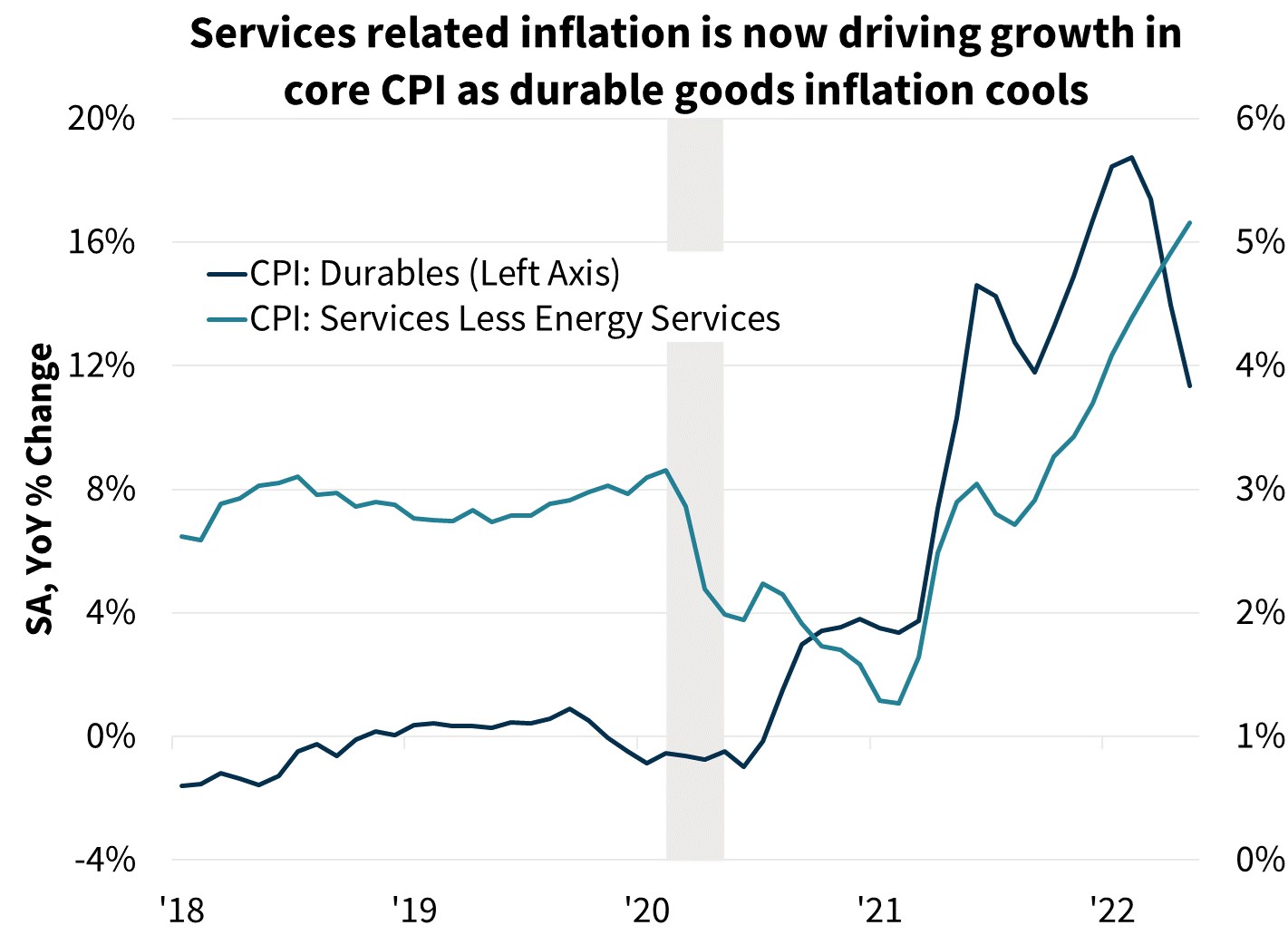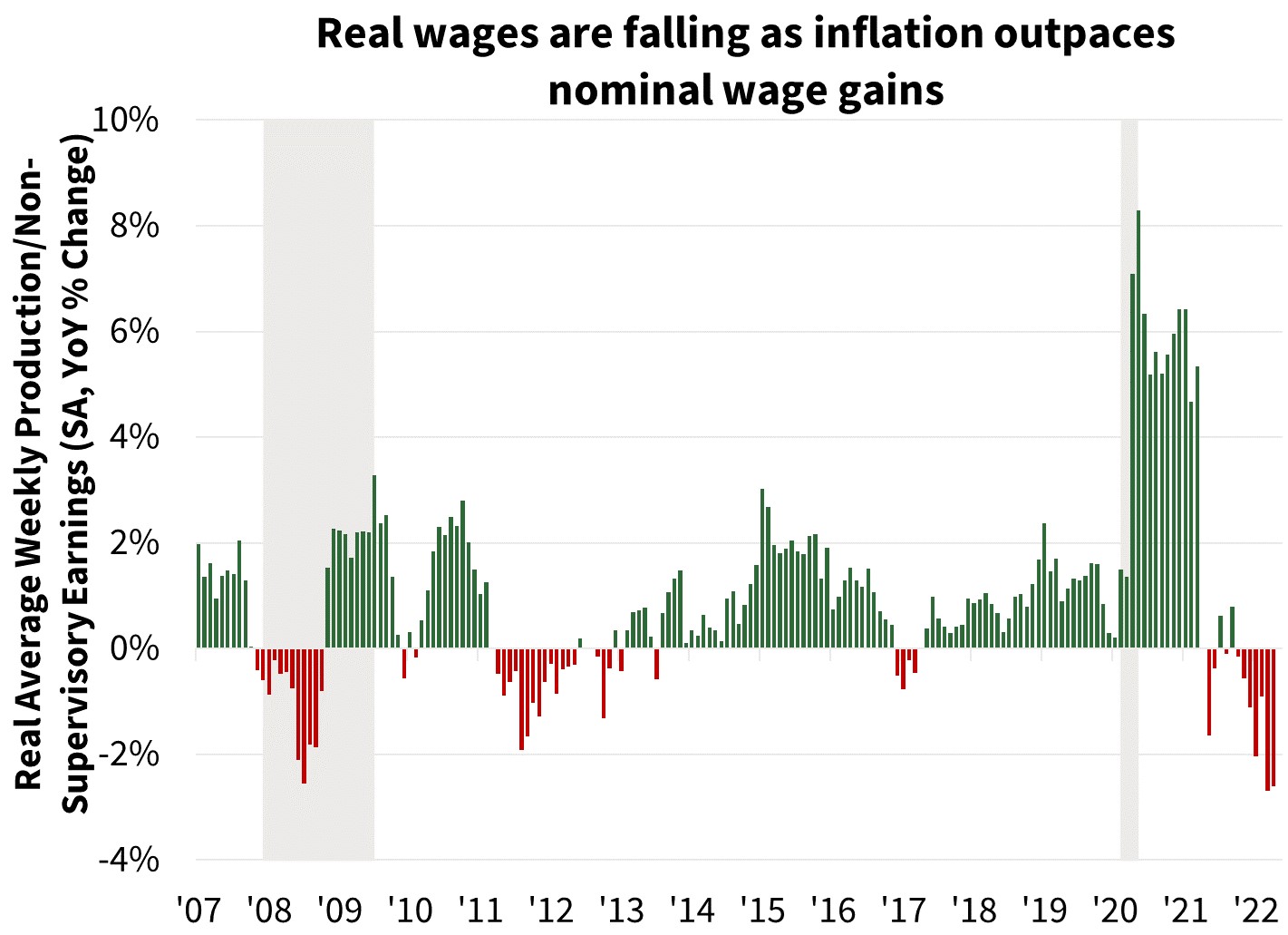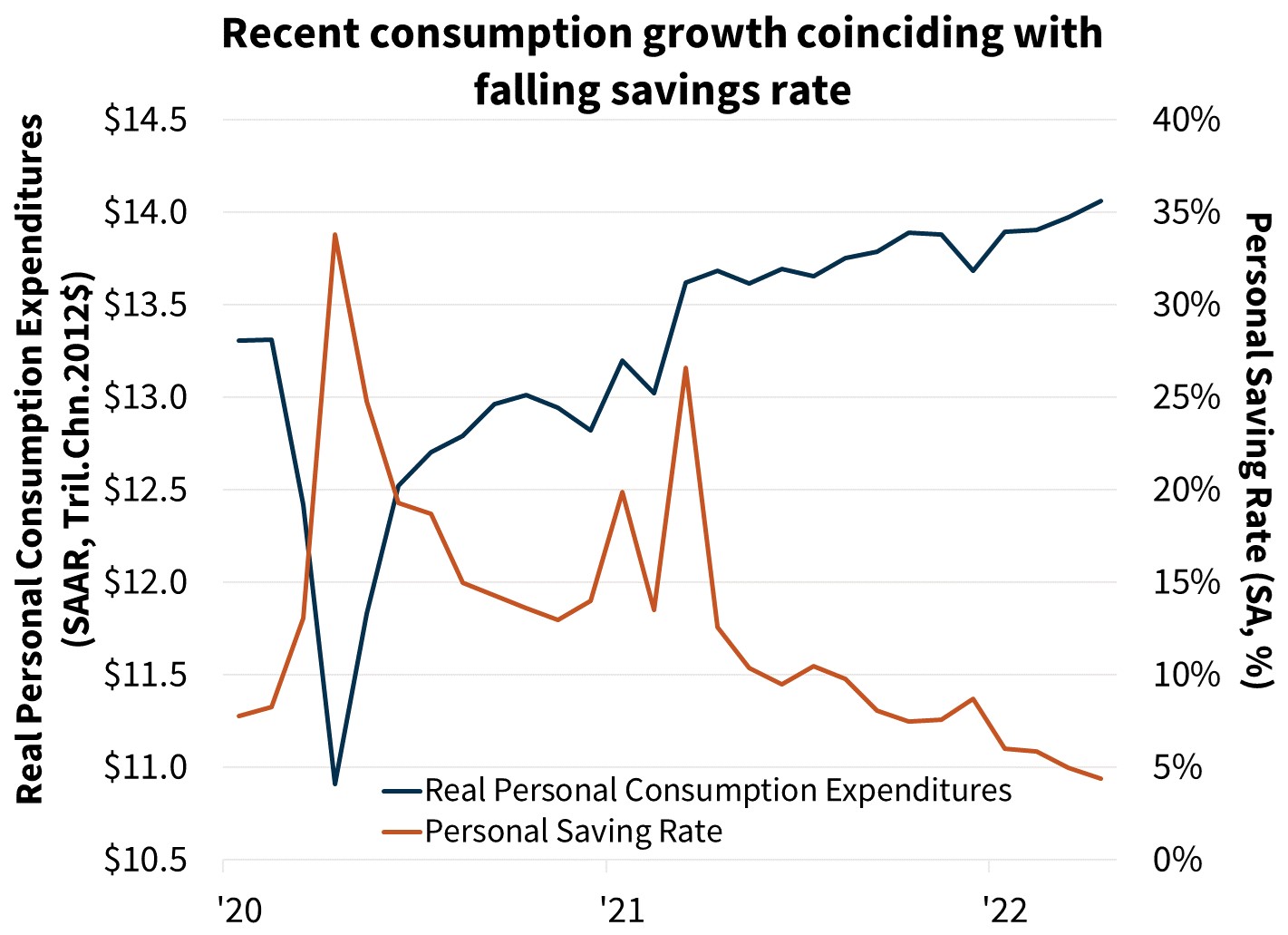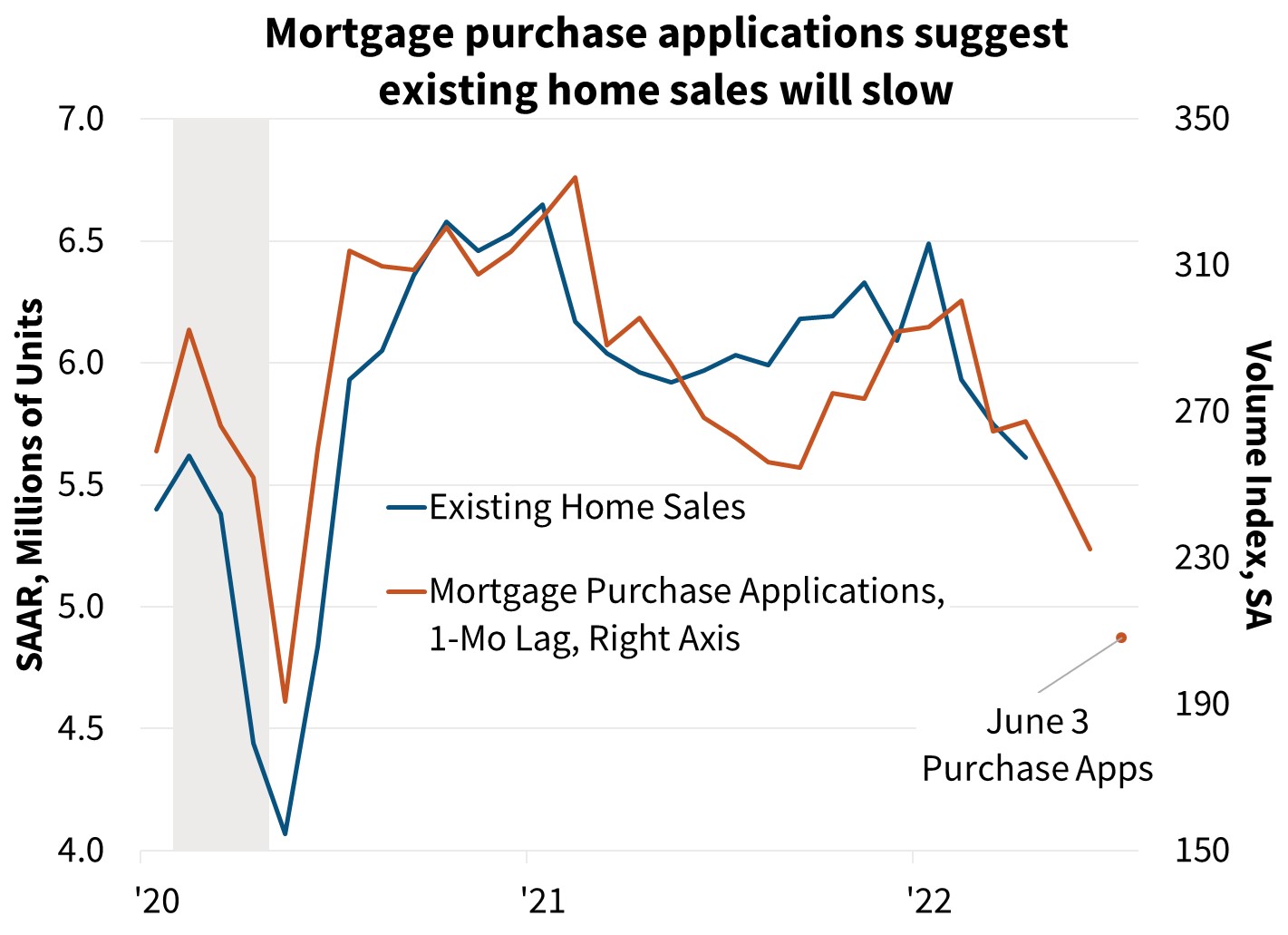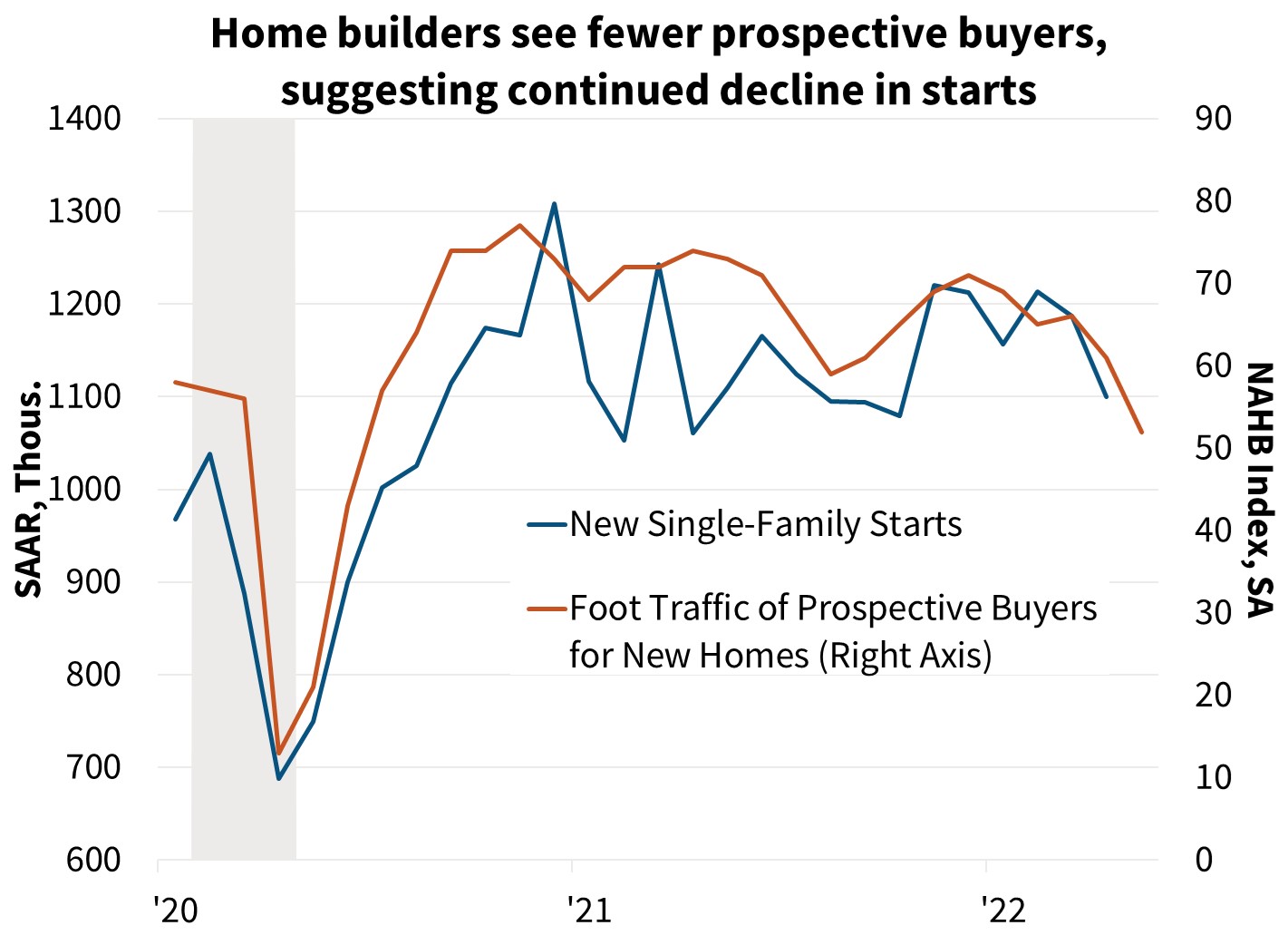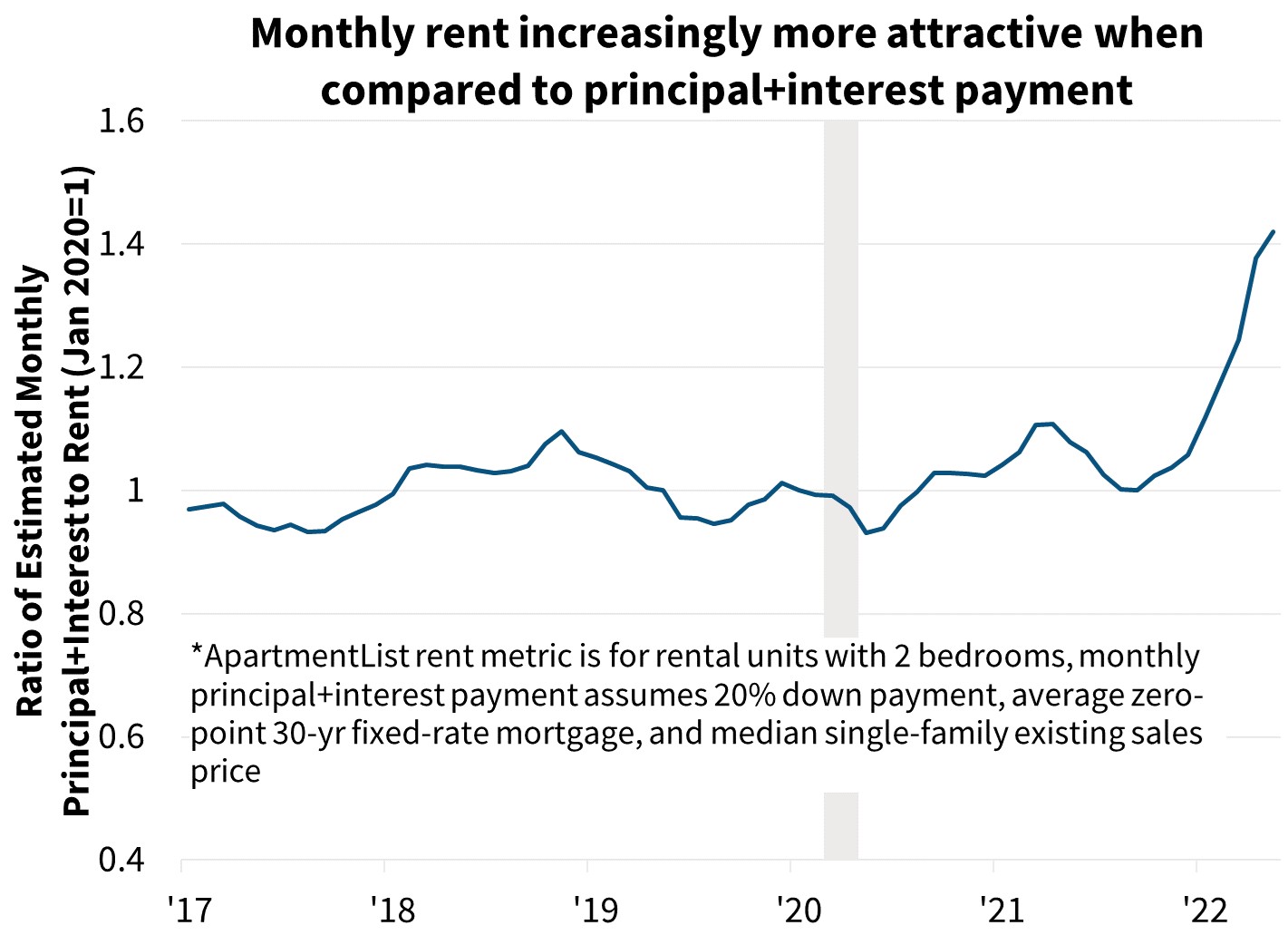Inflation Remains Hot as Home Sales Fall
We have ticked down by one-tenth our real gross domestic product (GDP) forecast to 1.2 percent growth in 2022 on a Q4/Q4 basis, followed by a decline of 0.1 percent in 2023 (no revision). The latter represents our continued expectation of a downturn occurring in the latter half of 2023. While the topline GDP path remains similar, we have made significant changes to our forecast of underlying GDP components, as well as the timing of growth. Taken as a whole, we have increased our Q2 2022 GDP growth expectation to 2.5 percent annualized (1.6 percent previously), driven by stronger consumer spending and net exports. This is offset, however, by a slower growth forecast for the back half of the year as inflation continues to eat into real incomes and the effects of higher interest rates take hold.
Our near-term inflation forecast has been upwardly revised considering another strong consumer price index (CPI) reading for the month of May, as well as recent increases in energy prices. While core inflation is still expected to ease modestly on an annual basis in coming months, reflecting the continued stabilization of goods prices, we now forecast headline CPI to average 8.9 percent on an annual basis in the third quarter (previously 6.9 percent), up from the most recent reading in May of 8.6 percent.
We have revised downward our forecast for total home sales in 2022 to 5.96 million units, a 13.5 percent decline from 2021 and steeper than our previous forecast of an 11.1 percent decline. The change was driven by much weaker-than-expected incoming new home sales data, as well as a more modest downward revision to existing home sales in light of incoming mortgage application data. Sales expectations for 2023 were also revised downward to a pace of 5.29 million units, from 5.42 million previously. Consistent with the sales downgrade, we have also revised lower our forecast for 2022 and 2023 mortgage originations to $2.61 trillion (previously $2.70 trillion) and $2.20 trillion (previously $2.25 trillion), respectively.
We also note that interest rates have moved significantly higher following the recent CPI release, which occurred after the conclusion of our interest rate forecast at the start of June. The 10-year Treasury yield as of this writing closed 52 basis points higher than at the time of our forecast, pointing to upside near-term risk of similar magnitude to our mortgage rate forecast, and downside risk to our forecast of home sales and mortgage originations.1
Inflation is Not Yet Slowing
April’s PCE inflation report showed moderating price increases and was raising hope that perhaps a more sustained deceleration was beginning. However, the May CPI report dashed that hope, increasing a full 1.0 percent month over month and 8.6 percent from a year prior, the highest since 1981. While much of the increase was due to surging energy prices, the rise was in part due to stronger-than-expected price pressures in non-energy components. Core inflation, which measures prices less food and energy, rose 0.6 percent over the month, similar to the brisk pace of previous months. Following the release of the report, market expectations of Fed interest rate hikes increased and, as of this writing, have priced in roughly 75 additional basis points of increases by end of year. The possibility that more aggressive policy tightening will be required to get inflation under control is increasingly being priced in by financial markets.
One positive sign in the CPI report was that durable goods prices rose only modestly by 0.1 percent month over month, continuing a trend of stabilization, with some outright declines in several categories. While goods prices affected by supply chain disruptions and surging demand were the primary drivers of inflation in 2021, continued strength in services and housing-related inflation components are now driving further rises in the index, despite an easing of durable goods inflation. As discussed in prior commentaries, we do not see services-related inflation receding until the labor market eases. The Fed has explicitly talked about needing to reduce the amount of job openings relative to job seekers to get wage growth to a level consistent with a 2-percent inflation target. The May employment report, which showed decelerating wage gains, and the most recent Job Openings and Labor Turnover Survey (JOLTS) report, which had job openings falling by roughly half a million, may point to early progress on these measures; though, in absolute terms the labor market remains very tight. Meanwhile, given that there is a significant time lag between rising home prices and rents, and these showing up in inflation measures, shelter-driven inflation is likely to remain strong for the rest of the year.
There also remains great uncertainty over energy and food prices given ongoing geopolitical events and bottle necks in oil refining and logistics. We expect gasoline and food prices to continue to rise through the summer, though predicting the magnitude is difficult and we are unsure if, or when, significant demand destruction would enter the equation. Inflation moving as high as 10 percent annually at some point over the late summer months is not out of the question.
A Lot Hinges on the Resiliency of the Consumer
Large upward data revisions to March retail sales and personal consumption points to significantly stronger consumer spending in the second quarter than previously anticipated, along with a correspondingly lower personal savings rate. One of the historical oddities of the current period is a mix of falling inflation-adjusted incomes coinciding with strong personal consumption. While real disposable personal income grew slightly in April following five months of declines, the reprieve is likely to be temporary given the surge in prices in May. On an annual basis, real disposable personal income was down 6.2 percent in April, while real average weekly earnings are down 3.9 percent. Typically, sustained negative real income growth usually occurs in or near recessions. However, to date, consumer spending has been maintained via households dipping into an also historically large built-up stock of savings, which were accumulated due to initial cutbacks in spending in 2020 and historically large fiscal transfers and monetary policy support. This is evidenced in part by a personal savings rate of 4.4 percent in April, compared to a pre-COVID norm above 7 percent. A big uncertainty to our forecast is to what extent consumers will or can continue to dip further into savings to maintain spending growth.
On paper, households still have a large amount of liquid “excess savings” in cash and checking accounts over $3 trillion above the pre-COVID level that could be used to support consumer spending. However, there are distributional aspects to this aggregate number. Our analysis of Federal Reserve data on household finances shows that the bottom two quintiles of households by income have on net largely exhausted their post-COVID “excess savings.” This is consistent with consumer credit card debt growing swiftly in April following a large rise in March. Many households appear to be tapping credit to maintain their spending levels in light of high inflation and lagging wages. As a ratio of personal income, total outstanding consumer debt still looks manageable by historical standards, but the pace of change is not sustainable. Therefore, our baseline forecast anticipates personal consumption spending to decelerate significantly in Q3 2022.
However, given the current episode lacks a historical parallel, it is useful to consider the implications of alternate scenarios regarding consumer spending resilience. If consumers are willing to take on more debt and dip more deeply into savings than we forecast, demand in the economy will remain stronger this year than we anticipate, most likely removing the risk of a late-2022 recession. However, this would also keep inflationary pressures higher and likely lead to a more aggressive pace of Fed policy tightening to combat it. The implication for housing is that in such a case mortgage rates may end up moving even higher as market expectations of more aggressive Fed tightening are priced in. While more resilient economic growth is supportive of housing demand, the rapid increase in mortgage rates is the dominant factor currently, and we would expect home sales to diminish further in such a scenario.
Alternatively, if consumers are nearing their exhaustion point and are unwilling or unable to dip further into credit and/or savings, then economic growth is likely to slow more greatly in Q3 and the future pace of Fed rate hiking may slow or come to an end by September. In such a scenario, the prospect of an earlier economic downturn comes into view. Although we’ve pointed to credit trends being unsustainable, hard consumption data does not suggest this outcome is imminent. Therefore, a near-term economic downturn is not our baseline forecast. Still, mortgage rates in such a situation will likely level off or even pull back, helping to support home sales even if the labor market begins to turn downward.
Home Sales are Falling Quickly
On a seasonally adjusted basis, existing home sales fell in April by 2.4 percent to a pace of 5.6 million annualized units; unadjusted, existing home sales were down 9.6 percent from the year prior. This was in line with our expectations. However, recent incoming mortgage application data points to a faster-than-anticipated further decline entering Q3 2022. As such, we have revised downward our existing sales expectations for the back half of the year. We expect seasonally adjusted sales to fall sequentially in Q3 and Q4 by a further 7.6 percent and 1.8 percent. Not counting disruptions in 2015 due to hurricanes, this translates into an anticipated Q4 2022 sales pace that is the lowest since Q1 2014 following the “Taper Tantrum.” As mentioned previously, the recent upward movement in interest rates since the completion of our rate forecast points to further downside risk to our already downwardly revised sales outlook.
New home sales came in well below expectations, plunging 16.6 percent over the month of April to the slowest pace since the April 2020 COVID-19 shutdowns. While we have downwardly revised our new home sales forecast, we are partially discounting the magnitude of the drop-off in this report. Beyond the series being volatile and subject to large revisions, we suspect that many homebuilders were caught off guard by the degree of mortgage rate increases this spring and the resulting shrinkage of homebuyer waiting lists. The number of new homes available for sale continues to grow, while a record number of homes are currently under construction. Up until now these have been hindered by labor shortages, construction bottle necks, and supply chain issues, but a large flow of homes being completed is still due to come down the pipeline. Publicly traded homebuilders continued to report larger-than-normal gross margins through Q1, suggesting that they will be able to make concessions and price cuts to move their inventories going forward if needed. We expect many builders will do just that, and, therefore, we anticipate a partial rebound in the pace of new home sales over the near term.
With that said, homebuilder expectations are weakening. While still strong, the latest National Association of Homebuilders’ confidence survey fell 8 points, with a significant decline in prospective foot traffic. While we expect the pace of housing starts to remain comparatively elevated in the near term reflecting the need to work through prior order backlogs, this suggests to us that construction will eventually soften as well. We are forecasting single-family housing starts to end the year about 15 percent lower than what occurred in the most recent reading for April.
With higher mortgage rates, the relative mix of housing demand by type may be changing. One factor bolstering home purchases over the past year was the resumption of large rent increases that made mortgage payments comparatively attractive despite strong house price growth. The ratio of median rent to median mortgage payment for a typical home was relatively constant in 2021. Using the national Apartment List Rent Estimate for 2-bedroom rental units, the median-priced single-family home, and current mortgage rates, the typical new mortgage payment compared to typical asking rent has grown swiftly and is now far less attractive on a relative basis. We expect this will be one of the factors weighing on single-family home sales while also helping to bolster multifamily rents and construction. We expect multifamily vacancy rates to tick up as the year progresses, primarily due to new supply coming online, but we still expect multifamily construction to remain comparatively resilient relative to single-family in part due to this rent vs. buy calculation taking place in many households.
Weaker Home Sales Outlook Implies Further Decline in Mortgage Originations
We expect total 2022 mortgage originations to be $2.6 trillion, $90 billion lower than last month’s forecast. In 2023, we expect mortgage originations to fall to $2.2 trillion, also a downgrade from last month. The downward revisions were, on net, entirely driven by lower expectations for purchase money mortgage originations primarily due to downward revisions to our home sales forecast.
For refinance originations, our forecast for 2022 remains at $797 billion, unchanged from last month. The forecast for 2023 was revised up moderately by $24 billion or 4.8 percent, given that we expect that mortgage rates will stabilize in 2023, and new acquisitions at the current rate are expected to be in-the-money again. Given recent jumps in mortgage rates, however, there is some downside risk to our refinance originations outlook. At 5.23 percent, the most recent Freddie Mac 30-year fixed-rate survey reading, we estimate that less than 2 percent of outstanding mortgages have a refinance rate incentive of at least 50 basis points. Cash-out refinances, which are less sensitive to interest rate movements, now make up the vast majority of total refinance volume.
1Our corporate interest rate forecast is a function of Treasury forward curves as of market closing on the final business day of the previous month. In this case, it was a forecast based on market rates as of May 31, 2022.
Economic & Strategic Research (ESR) Group
June 13, 2022
For a snapshot of macroeconomic and housing data between the monthly forecasts, please read ESR’s Economic and Housing Weekly Notes.
Data sources for charts: Bureau of Labor Statistics, Bureau of Economic Analysis, National Association of REALTORS®, Mortgage Bankers Association, Freddie Mac, Census Bureau, ApartmentList.com, National Association of Home Builders, Fannie Mae ESR Analysis.
Opinions, analyses, estimates, forecasts and other views of Fannie Mae's Economic & Strategic Research (ESR) Group included in these materials should not be construed as indicating Fannie Mae's business prospects or expected results, are based on a number of assumptions, and are subject to change without notice. How this information affects Fannie Mae will depend on many factors. Although the ESR group bases its opinions, analyses, estimates, forecasts and other views on information it considers reliable, it does not guarantee that the information provided in these materials is accurate, current or suitable for any particular purpose. Changes in the assumptions or the information underlying these views could produce materially different results. The analyses, opinions, estimates, forecasts and other views published by the ESR group represent the views of that group as of the date indicated and do not necessarily represent the views of Fannie Mae or its management.
ESR Macroeconomic Forecast Team
- Doug Duncan, SVP and Chief Economist
- Mark Palim, VP and Deputy Chief Economist
- Eric Brescia, Economics Manager
- Nick Embrey, Economist
- Nathaniel Drake, Economic Analyst
- Richard Goyette, Economic Analyst
